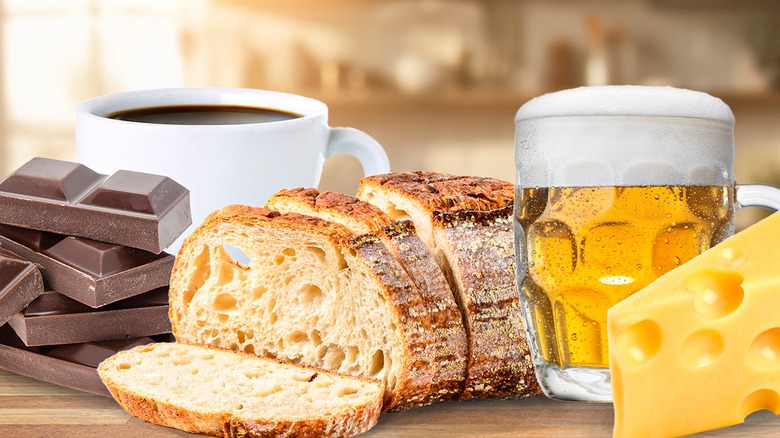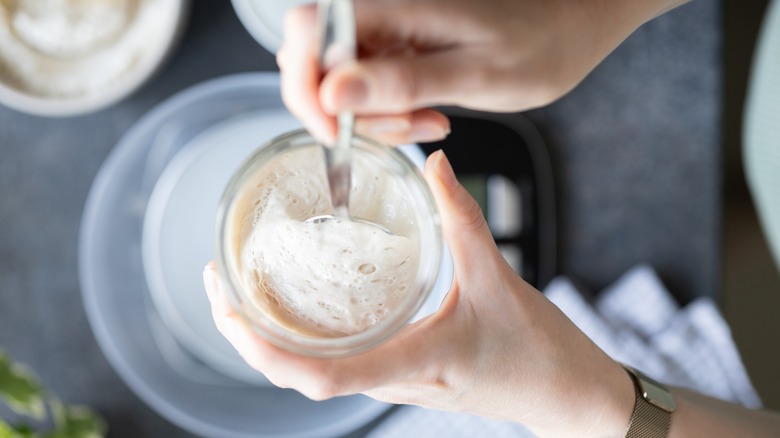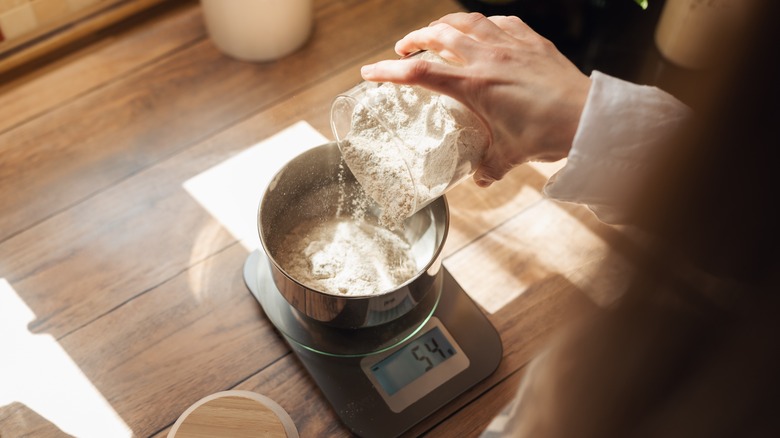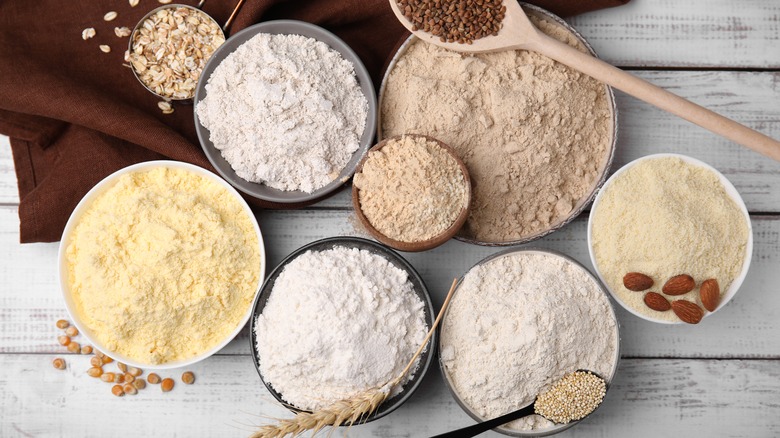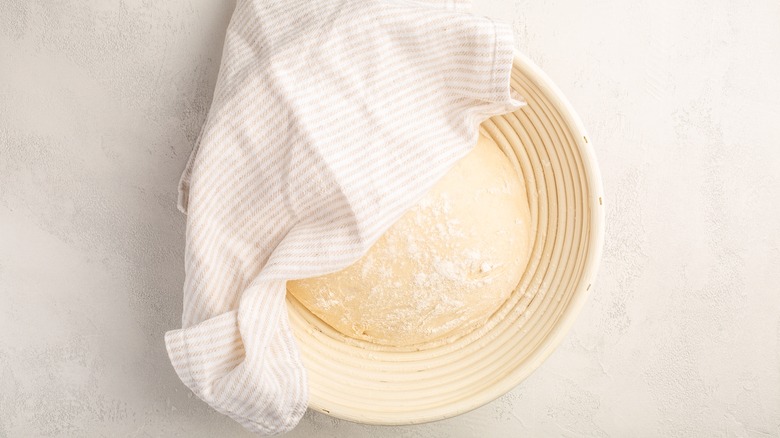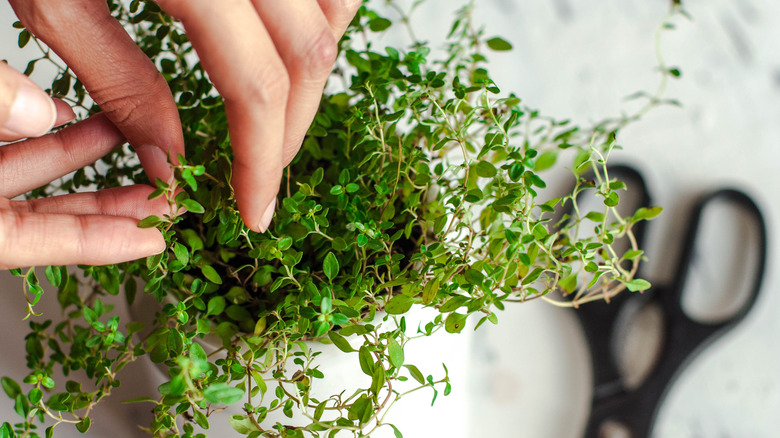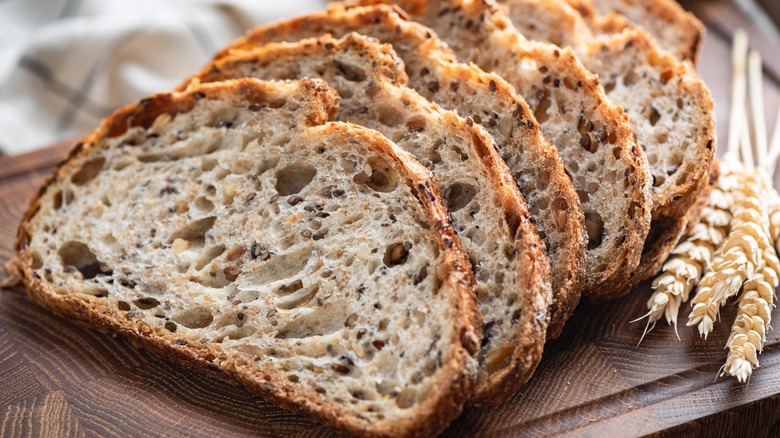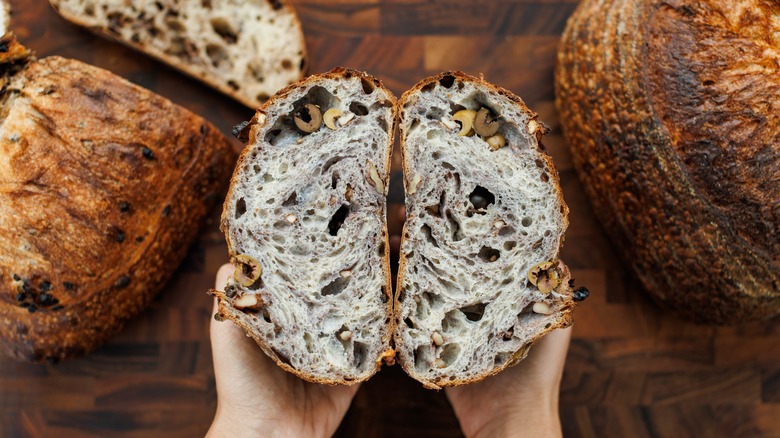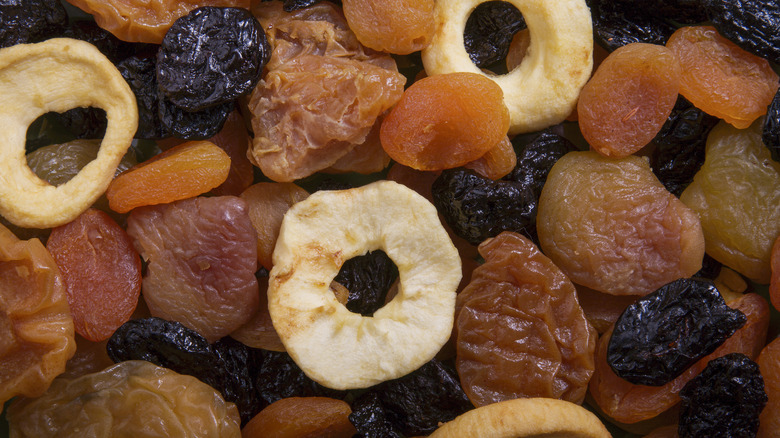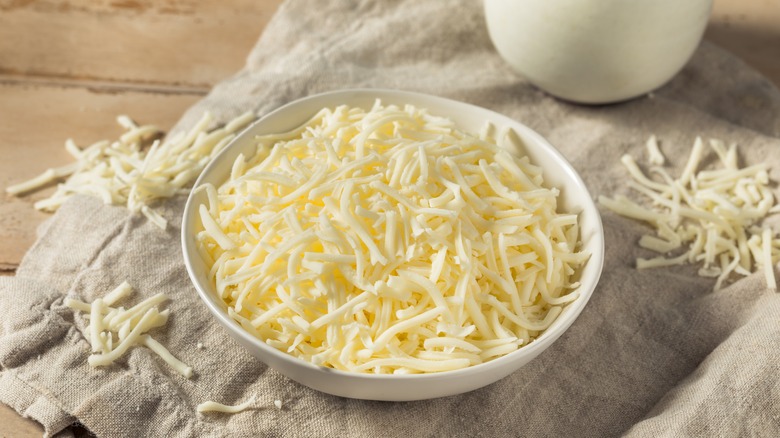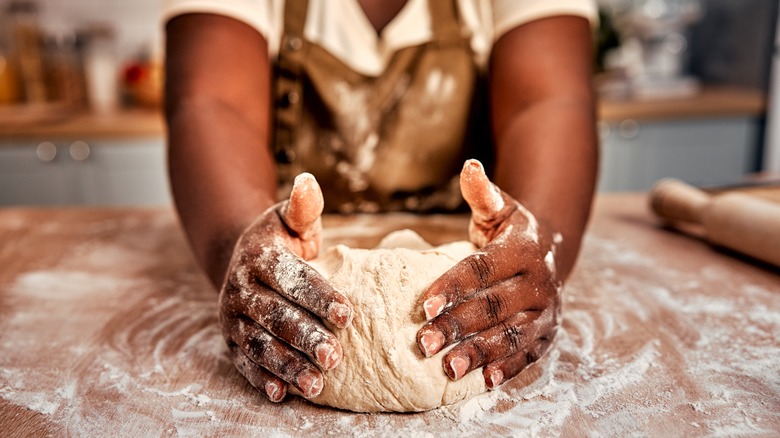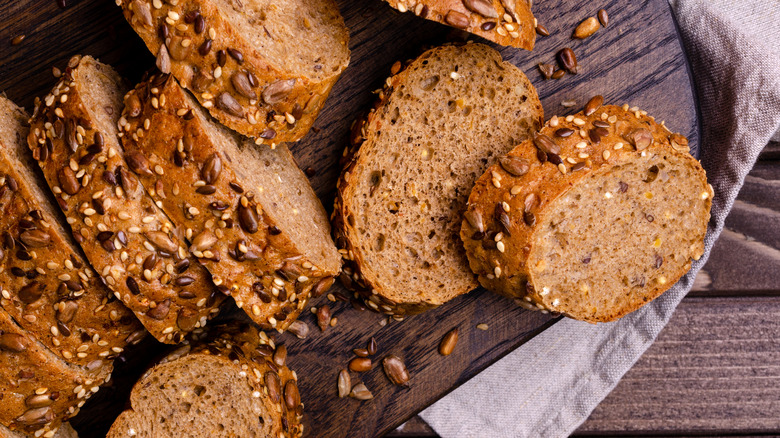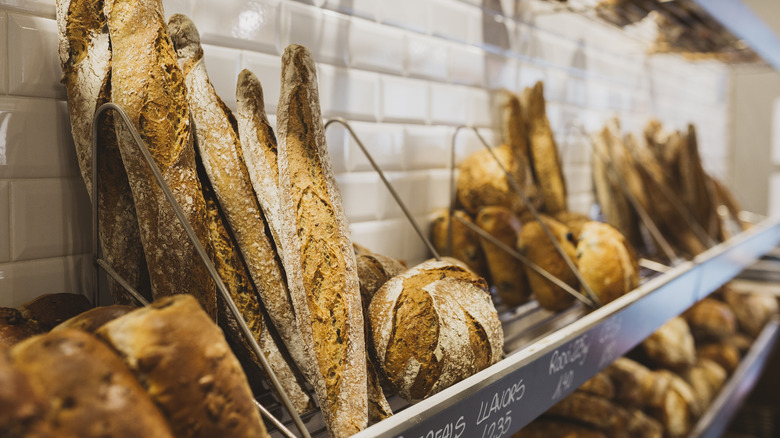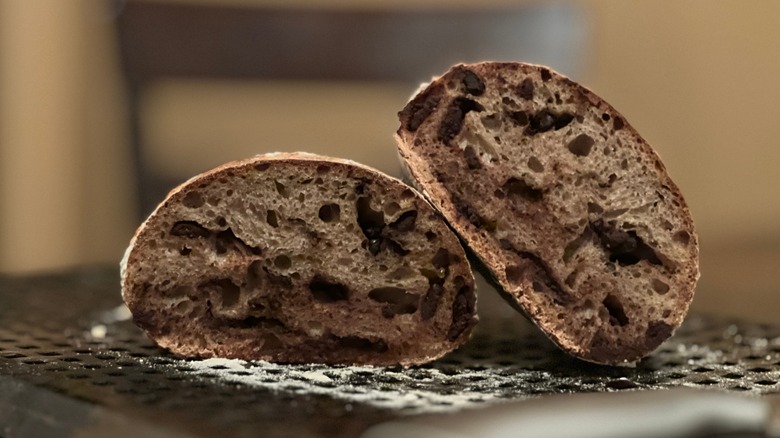15 Ways Bakery Owners Add More Flavor To Sourdough
Nothing beats taking a fresh loaf of sourdough bread out of the oven. The subtly tangy aroma of the starter, the burnished crust, the crackling as the bread contracts while it cools — it's enough to make your mouth water.
Whether you're a novice just learning the ins and outs of transforming four simple ingredients (flour, water, salt, and yeast) into bread or a veteran baker expanding your carbohydrate repertoire, there are so many ways to take the flavor of your bread to the next level. There are also a lot of expert bakers more than willing to share a few tricks of the trade to help you achieve sourdough success at home.
Ellen King is the co-owner and director of baking operations at Hewn, a Chicago-area bakery using local grains, produce, and dairy to produce naturally leavened and nationally recognized loaves. Ran Zimon is the founder of Bread Lounge in Los Angeles, a bakery and coffee shop producing European-style baked goods alongside a Mediterranean café menu.
These seasoned bakers know how to make bread taste amazing, and they've shared their insights with us. From heirloom wheat to ancient grains, surprising add-ins to expert techniques translated for the home kitchen, these are the tips you need to add even more flavor to your sourdough bread.
Change how you handle your starter
You can't make sourdough bread without a sourdough starter. With a little time and some fresh air, equal parts water and flour become inoculated with wild yeast. Regular feedings strengthen the mixture, enabling it to create the rise you need for lofty, airy sourdough bread.
Your starter makes bread rise, but it also imparts flavor into your loaf — which means the amount of starter you use will change how your bread tastes. To make your sourdough bread taste more or less sour, you'll need to change the amount of acid by adjusting how you make your bread, from the preferment to the hydration of the dough to the rising time and temperature.
For a more mild loaf, use cooler water and unbleached white flour, and bake your loaf immediately instead of retarding the rise in the refrigerator to give the lactic acid bacteria less time to create acids. If you want to amp up your bread's sour flavor, do the opposite! Opt for a looser preferment and feed your starter more to give it lots of water and flour to work with. Make the dough with warmer water and some whole grain flour. A warm bulk ferment will allow the dough to develop sour flavors, while a refrigerated, a second rise enables those flavors to develop more deeply.
Use artisanal flours
The flour you use will do a lot to impact how your sourdough bread tastes. "Each flour has different characteristic and bring different flavors to a loaf of bread," says Ran Zimon of Bread Lounge, who likes to mix whole wheat, rye, and buckwheat flour into loaves for more complex flavor.
If your local grocery store has a selection to choose from, that is a great place to start — but nothing compares to the flavor of artisanal flour. These flours are lovingly grown, carefully processed, and milled for specific uses. Stone milling is an age-old process that grinds whole grains into flour and incorporates the whole kernel, including the bran and germ, into the final product. This increases both the flavor and the health benefits of the flour by keeping the proteins, oils, vitamins, and minerals.
Even a light and mild loaf made with artisanal flour will have lots of flavor. "I am a minimalist and love the blonde country batard we make," says Ellen King. "It uses two types of stone milled flour from Janie's Organic farm, [and the] loaf is a little lighter than our traditional country loaf." Who says white bread has to be boring?
Incorporate other grains
There is so much that can be added to bread beyond just wheat flour. Grains can be milled, cooked, or stirred in whole to change your bread's flavor and texture. Rye flours are readily available at grocery stores, making them a great choice for an adventurous home baker. A white rye will produce a subtle and softer baked good, while pumpernickel flour produces hearty, dark bread (popular with pastrami).
Ellen King uses stone-milled grains to create higher-protein breads with a nutty flavor. "... I'll add 50% sifted bread flour with 25% einkorn, 25% spelt," she suggests. Einkorn is an ancient and primitive form of wheat with a toasty, nutty flavor. Spelt is another ancient whole grain with a nutty flavor that produces hearty bread.
King continues: "To add different flavors we will sometimes use a porridge, or loose polenta, spent grains (from a local brewery) to add flavor or texture." Polenta porridge will give your bread a bit of bite and a sweeter corn flavor, while spent grain bread will have more chew and a malty, grain-forward taste.
Replace water with other liquids
With only four basic ingredients, a simple swap can make a big difference in your sourdough bread. Replacing the water in your recipe with a more flavorful liquid — beer, scalded milk, and fruit or vegetable juices, for example — will shift the taste and texture of your final product.
Changing the liquid is not quite as straightforward as a 1:1 swap. "When swapping water with other liquids, I recommend keeping in mind that liquid containing sugar, like grape juice, for example, will affect the rising time of the dough," says Ran Zimon, "So adjusting the yeast percentage might be needed."
Other liquids can have other impacts. Milk, for example, can prevent your bread from rising if it isn't handled properly. The whey protein in fresh milk will weaken gluten, making it hard for yeast to do its job. Scalding the milk (heating it to just below boiling, then cooling it back to room temperature) weakens those proteins, allowing you to get the fat and flavor of milk into your bread while still getting a good rise.
Since beer and bread have nearly identical ingredients, using it is a no brainer — as well as a major flavor bomb. Keep an eye on your dough during the first fermentation, as the additional yeast from the beer may cause your dough to rise faster than usual.
Opt for a slower cold fermentation
Have you ever noticed how the smell of your starter changes depending on how ripe it is? The more time your starter has to ferment, the stronger the smell will be, and the same goes for your dough.
After you've combined your starter with the rest of your dough ingredients, the dough undergoes bulk fermentation. A warmer bulk fermentation causes the dough to rise quickly, giving it less time to develop sour flavors. If you want to enhance the sour flavors of your bread, keep things cool. Incorporate a fermentation period in the refrigerator, either as part of the bulk fermentation process or as the final rise after the dough has been shaped.
When baking with stone-milled grains, Ellen King adjusts the bulk fermentation time to achieve a balance of flavor between nutty grains and the desired sour notes. "We will reduce the bulk fermentation by 30-60 minutes, then retard the shaped loaves in the refrigerator for 12-14 hours," she explains. This allows the bread to ferment slowly and develop that more sour flavor.
Change your cooking techniques
Changing your ingredients will change the flavor of your bread, and so will changing the way you bake it. Switching from a gas oven to wood fire and adding steam can impact the way your sourdough bread tastes.
Steam helps the outer skin of your bread stay stretchy during the beginning of the baking process, allowing it to rise to its full potential before the crust hardens. In a professional bakery, adding steam to the oven is as simple as pushing a button. For home bakers, a common practice is to bake sourdough bread in a Dutch oven, starting with the lid on to trap steam before removing it to crisp up the crust. You can also put a pan of water into the bottom of your oven, which will turn to steam at high baking temperatures.
Another way to add flavor is to change your heat source. Use a wood-fired oven (like an Ooni or other outdoor pizza oven), using the smoke from the wood and the wood you choose to impart flavor that can take your sourdough bread to the next level.
Mix in herbs and spices
If you thought fresh herbs and spices smelled amazing on their own, wait until you smell them wafting from a warm loaf of sourdough bread. These add-ins are a great way to increase your bread's flavor without affecting the rising or baking process.
Ran Zimon loves to use rosemary, and a potato-rosemary loaf is one of Bread Lounge's signatures. "A small amount will add a lot of flavor," Zimon explains. Other herbs, like thyme or lavender, are also great choices for a fragrant loaf of bread. If you only have dry herbs on hand, use less than you would with fresh herbs, as dry herbs have a much stronger flavor.
For even more complexity, add ground spices to the mix. You'll often spot caraway in rye bread (ground or as whole seeds), and cinnamon swirled into a cinnamon-raisin loaf. Turmeric would add an earthy flavor, as well as an eye-catching color, to your sourdough.
Add texture with nuts and seeds
A great loaf of bread is all about contrasting textures. Beneath the crisp, crackly crust is (hopefully) a tender, airy crumb with a bit of chew. But if you want your loaf to have even more bite, add nuts or seeds for some crunch and extra flavor.
"We use a lot of seeds in our loaves, such as sunflower seeds, sesame seeds, pepitas, and nuts, such as walnuts [and] hazelnuts," says Ran Zimon. Take some time to properly toast and cool your nuts before folding them into the bread dough, and you'll wind up with a loaf that's loaded with texture.
Toasting increases the flavor. Heat draws out oils so the flavor and aroma of your nuts and seeds are more pronounced. It also ensures your nuts will be cooked and crunchy. When wrapped in moist bread dough, it's impossible for the nuts or seeds to do anything except steam. This will result in bits of nuts or seeds that are squidgy instead of toothsome, which is probably not what you're going for.
Use fruits and vegetables for a burst of flavor
When fruits and vegetables are in season, they can be a delicious addition to a sourdough bread recipe. Chop up a chili, grate a zucchini, or fold in fresh blueberries for a pop of color and a major burst of flavor.
When adding fresh ingredients, consider their moisture level and adjust your dough accordingly. Treat wet ingredients like zucchini or puréed beets or squash as part of the total volume of water in your dough. Whole fruits, like blueberries, or chopped bits of jalapeños won't release as much liquid so you can mix them in without as much worry about the water content.
"Olives add a lot of flavor," says Ran Zimon, "but they contain salt, so you might have to adjust the salt in your recipe." Remove olives from the brine, rinse, and give them a chance to dry. It's up to you whether to keep them whole or chop them into smaller pieces — just check for pits!
Use alcohol to rehydrate dried fruit
Toasted cinnamon raisin bread takes us right back to childhood weekend mornings, and that nostalgia can be yours with a few fistfuls of dried fruit mixed into your dough. But, as Ran Zimon points out, dried fruit will absorb the water in your dough. Zimon suggests soaking the fruit in water before adding it to the dough, but there's another choice: alcohol.
At Hewn, Ellen King uses dried fruits in loaves like her cranberry walnut bread, seasonal chocolate cherry bread, and weekly raisin challahs. "There are times we soak the fruit in rum, brandy, or bourbon to add a depth of flavor," King explains.
While alcohol is a byproduct of yeast fermentation, if you add too much alcohol to your bread dough, it can actually inhibit yeast's fermentation and eventually kill the yeast. Dough with dead yeast doesn't rise, so be judicious with how much alcohol is added to your dough. Soak the dried fruit to rehydrate it, then strain off any extra liquid to keep your starter strong.
Here's how to add cheese to your bread
Love a sourdough grilled cheese sandwich? Get even cheesier by adding chunks of cheddar or mounds of manchego directly to your dough. Unlike olives or fresh fruit, firm cheeses have a low moisture content, so they won't make your dough extra wet. The way you handle your cheese will, however, impact your eating experience. Cubes of cheese will create pockets of stretchy cheese surrounded by plain bread, while shredded cheese will infuse every bite with a hint of cheesy goodness. Or use a bit of both for an intensely cheesy loaf of bread.
Cheese on its own is delicious, but don't miss your opportunity for a dairy-forward flavor combination. Hewn offers loaves studded with aged cheddar, as well as a savory combination of parmesan and roasted garlic. Cheddar pairs beautifully with diced jalapeños (pickled or fresh), manchego shines alongside rosemary, or you can really go for it with multiple cheeses together.
Bake gluten-free sourdough bread
Gluten-free sourdough bread? Yes, it can be done. Most sourdough starters are made and fed with traditional flour, so you'll need to create a gluten-free starter for truly gluten-free bread.
Use the same method you would for a traditional starter, but replace white or wheat flour with a gluten-free alternative such as brown rice flour or buckwheat. Be patient, continuing to discard and feed your starter until it is very active to give your gluten-free sourdough bread the best possible lift.
When it comes to baking, in addition to naturally gluten-free flours like buckwheat, many brands make gluten-free bread and all-purpose flours. Be sure to read the packaging, though, as some flours (including 1:1 replacements for traditional flour) are not recommended for use in yeasted bread. Why? 1:1 flours don't usually have enough stabilizers in them to create the structure needed to replace gluten in bread-making, which would lead to a flat and tough loaf instead of one that's lofty and tender.
Consider the crust
Why let the inside of your bread have all the flavorful fun? Use surface area to your advantage and make your crust the real star of the show. Hewn, for example, tops its Holmenkollen Rye with flax, pumpkin, sunflower, and sesame seeds. How epic would that be in a sandwich?
Spread your toppings on a dry towel on the counter or in a wide, shallow bowl, and gently roll your shaped dough through the seeds before putting it into the proofing basket, with the seeds on the bottom and the seam of your loaf on top. This way, when you flip your loaf onto your baking pan, the seeds are on top.
The toppings you use can stand alone, like the seeds on the outside of a bagel. You can also use the same types of seeds or grains inside your bread for a one-two punch of flavor.
Change up your loaf style
For bakers who usually turn out country loaves or boules, switching up the type of bread you're making is a great way to both expand your repertoire and explore different flavors. Though the essential ingredients — flour, water, salt, and yeast — are the same, a change in technique goes a long way in creating completely distinct flavors.
Take ciabatta and baguette, for example. Traditional ciabatta uses a very wet dough, resulting in a short, wide loaf with large air holes and a tender, moist center surrounded by a thin and pale, crispy crust. Baguettes are long, thin loaves with notable, irregular air pockets inside and a darker, more hearty crust.
"Our baguette and ciabatta are similar to each other in that they use a poolish and starter," says Ellen King. A poolish is a preferment made from flour, water, and commercial yeast, whereas a starter is made with flour, water, and wild yeast. These breads have a much shorter fermentation time, which results in a less sour flavor.
Add sweet ingredients to your bread
Making sourdough bread is a labor of love, and if you love bread enough to take on such a big project, you would probably be happy eating a slice of freshly baked bread any time of day, including for dessert. But why stop there? Turn your sourdough bread into a real dessert (or the perfect starting place for some serious French toast) by incorporating sweet elements.
The first thing that comes to mind? Chocolate, of course. Hewn's chocolate and cherry bread is only available seasonally, but it's enough to inspire us to fold dried cherries and chunks of chocolate into our loaves. Add cocoa powder to enhance the chocolate flavor even more.
Cinnamon raisin bread is another obvious choice. Cinnamon has antimicrobial properties that can slow fermentation, so your dough may not behave exactly as expected. To avoid this problem, spread a combination of cinnamon and sugar on your dough during the shaping process instead of mixing it in at the beginning.
